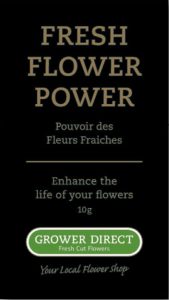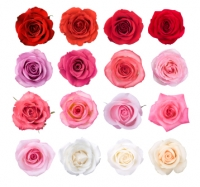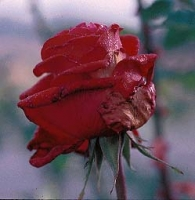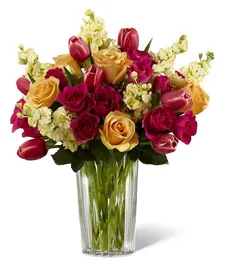![]() Prices in Canadian Dollars.
Prices in Canadian Dollars.![]() Prefer to call and speak to a floral agent? 1-877-277-4787
Prefer to call and speak to a floral agent? 1-877-277-4787
Cut Flower Care
Grower Direct has taken the utmost care to ensure the flowers we deliver to our customers homes and workplaces are as fresh and beautiful as possible. We begin the process by acquiring our flowers from the industries finest flower growers and partnering with only the best FTD retail florists. By doing so we can be confident that only the finest fresh flowers are being delivered to our customers.
However, to achieve maximum enjoyment and longevity from their flowers, our customers need to provide a little “TLC” when the flowers arrive.
Fortunately, what is required is very simple. Here are a few easy steps to follow that will ensure that your flowers look their best. Follow them and your flowers will look great and last for as long as possible.
1) Start with a clean vase & good quality water!
One of the largest deterrents to fresh cut flower life is bacterial. Bacteria and fungi are everywhere and are ready to enter the cut surface of the stem and multiply. Prior to actual decay symptoms, cells of the water-transporting tissues can become blocked with microorganisms, inhibiting water uptake.
A plant’s root system serves as a filter to limit dirt, micro-organisms and chemicals from entering and blocking the plant’s ability to absorb water. When the flower is cut off from its life-sustaining root system, it loses this vital filter. It is important, therefore, to always start with clean water in order to protect and preserve the flower.
Always use warm (100 – 110 degree) clean water as most flowers take in warm water more efficiently than cold. The actual quality of water used in a vase plays a major role in a flowers life cycle as examples;
- Sodium – Present in high concentrations in soft water, particularly if softened using salt, is toxic to roses and carnations.
- Fluoride – Added to drinking water in many communities for dental health. While Fluoride may prevent cavities in the kids it is harmful to gerbera, gladiolus, and freesia.
- Minerals – In many areas drinking water is considered “hard” and contains high levels of minerals. Dissolved minerals can and may block the flower stems ability to hydrate properly.
 2) Use the Flower Food provided.
2) Use the Flower Food provided.
While a flower is attached to the plant, it receives nourishment allowing it to grow and develop. When cut from the plant, it loses its source of nourishment and water. Fresh Flower Food has been developed to simulate the flower’s original environment, and allow the flower to fully develop (open).
While it is easy to find all sorts of home recipes and folklore about common household products that can be used to extend the life of your flowers, like many things this is best left to the professionals. Commercial Fresh Flower Food will increase the life of cut flowers and should always be used, these formula’s are scientifically developed, carefully balanced mixtures generally containing,
- Sucrose (sugar); Sucrose serves as a source of energy (food) to make up for the loss of the functioning leaves and insures continued development and longevity of the flower. Like all other living things flowers require food energy, however too much sucrose can be a bad thing as it can “force” the life cycle of the flower to proceed faster than normal.
- Acidifier ; Most water supplies are alkaline and can reduce the life of cut flowers, an acidifier will help bring the waters pH closer to the acid pH of the cell sap. Slightly acidic water is taken up more readily through the stems than water that is neutral or alkaline. The acidifier also aids in stabilizing the pigment and the colour of the flowers.
- Inhibitor of microorganisms (bacteria); Designed to retard the growth of bacteria in the water. While flowers require and “enjoy dining” on sucrose, so does bacteria. Cells of the water-transporting tissues in flowers can become blocked with microorganisms, inhibiting the flowers ability to hydrate and severely reducing longevity.
- Agents To draw out certain salts, dirt, and debris which will settle rather then being drawn up the flower stem.
Follow the directions on the package and always use the recommended amount. Don’t take short cuts or “play it on the safe side” by using too much flower food, either way can be just as harmful.
3) Cut Stems & Remove Foliage
Re-cut the stems at an angle removing at least on inch of the stem. Always use a sharp knife or clippers rather than scissors as this will avoid crushing the stem and therefore the vascular system. The slanted cut opens more stem area for hydration and prevents the end of the stem from resting directly on the bottom of the vase impeding water flow.
Leaves that will be below the water line in the container must be removed. Leaves sitting in water will deteriorate and rot. Decaying leaves make a good medium for bacteria and fungi, which will plug the vascular system preventing hydration and eventually causing death. DO NOT remove all leaves along the stem length, the flowers require the leaves as part of their hydration process. Always be “gentle” during the removal of leaves, gashes or breaks in the stem surface are “open wounds” where bacteria may enter. Try using a soft, but impenetrable glove for the removal of rose thorns and foliage.
4) Last but not least
Check the water level daily and replenish as needed. If the water becomes cloudy, it should be completely exchanged forfresh. As the water level gets low, you must re-fill vases with fresh solution made with correct proportions of Fresh Flower Food and water.
NOTE For roses, this process can be performed on Day 1 (when you first purchase product), on Day 3, and again on Day 5, doing so will help you obtain maximum vase life.
Now, enjoy your flowers!
Do’s and Don’ts Of Fresh Flower Care
Do’s:
- Always uses a clean vase and quality water.
- Always use the fresh flower food provided.
- Always re-cut your flowers initially.
- Always remove the leaves below the water line.
- Always check the water daily and top it up.
- Remove any flowers that with time look less than pristine, as this will keep the remaining flowers looking fresh.
Don’ts
- Never use a “home made” substitute for flower food such as aspirin, soda pop, or bleach.
- Never remove all foliage from the stem
- Never place your flowers with or near fresh fruit or cigarette smoke as both produce ethylene gas which will shorten flower life.
- Never place flowers in direct sunlight, near a heat register, or near any other source of excessive heat.
- Never use flower food in crystal or metal containers as the acid in the flower food will react with metal (including the lead in crystal)

Flower Vase Life
A general outline of what you can do to extend the life of fresh cut flowers in your home
Cut Flower Care- FAQ
Cut Flower Care- FAQ At Grower Direct we have spent over two decades developing a system to ensure that our flowers travel from farm to our customers as quickly as possible and during that time receive the best TLC. However once they leave our stores t

Diseases Due To Lack of Post Harvest Care
Botrytis – a disease that can affect fresh cut flowers due to lack of post harvest care.
Flower Care – Ethylene Gas
Grower Direct Flower Care – What is Ethylene? How it effects flowers vase life.



